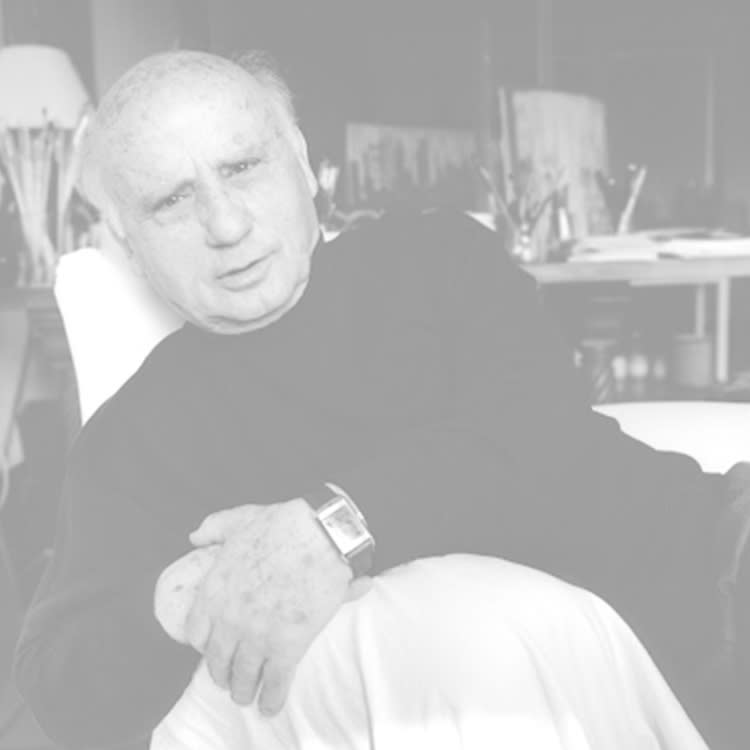MANUEL CARGALEIRO B. 1927-2024
Manuel Cargaleiro is an internationally renowned Portuguese artist whose unique work is exhibited at HELENE BAILLY gallery. Blending painting and ceramics, he develops a vibrant artistic language where geometric shapes and striking colors interact in perfect harmony.
Recognized as an undisputed master of contemporary azulejo, Cargaleiro has left a lasting mark on the history of modern art and mural ceramics. His work stands out for its innovative approach to patterns, blending Portuguese heritage with influences from lyrical abstraction.
Born in 1927 in Chão das Servas, Portugal, he began his artistic journey in 1945, before abandoning his studies in natural sciences to fully dedicate himself to the arts. In 1952, he held his first solo exhibition in Lisbon and started teaching at the António Arroyo School of Decorative Arts. He became part of Lisbon’s intellectual and artistic circles, particularly the Gelo Group, alongside prominent figures of Portuguese Surrealism.
With a scholarship from the Italian government, he refined his skills as a ceramicist in Florence, Rome, and Faenza, before moving to France in 1957, where he settled permanently. Influenced by École de Paris artists such as Delaunay, Vasarely, and Klee, he developed a distinctive style, combining geometric modularity with a sophisticated chromatic palette.
Throughout his career, he created monumental works, including public commissions in France, Italy, and Portugal. Among his most notable projects were the murals at the Champs-Élysées – Clémenceau metro station in Paris (1995) and works for the Vietri Museum in Italy. He was honored with numerous distinctions, including the title of Officier des Arts et des Lettres in France and the Grand Cross of the Order of Merit in Portugal.
Committed to preserving and sharing his art, he established the Manuel Cargaleiro Foundation in Lisbon in 1990, donating a vast collection of his works. He also inaugurated several museums dedicated to his legacy, including the Manuel Cargaleiro Museum in Castelo Branco (2005, Portugal) and the Museo Artistico e Industriale Manuel Cargaleiro in Vietri sul Mare (2004, Italy), later relocated to Ravello in 2015.
He passed away on June 30, 2024, in Castelo Branco, Portugal, leaving behind a remarkable artistic legacy that continues to inspire generations.
-
 MANUEL CARGALEIRO
MANUEL CARGALEIRO -
 MANUEL CARGALEIRO
MANUEL CARGALEIRO -
 MANUEL CARGALEIRO
MANUEL CARGALEIRO -
 MANUEL CARGALEIRO
MANUEL CARGALEIRO -
 MANUEL CARGALEIRO
MANUEL CARGALEIRO -
 MANUEL CARGALEIRO
MANUEL CARGALEIRO -
 MANUEL CARGALEIRO
MANUEL CARGALEIRO -
 MANUEL CARGALEIRO
MANUEL CARGALEIRO -
 MANUEL CARGALEIRO
MANUEL CARGALEIRO -
 MANUEL CARGALEIRO
MANUEL CARGALEIRO -
 MANUEL CARGALEIRO
MANUEL CARGALEIRO -
 MANUEL CARGALEIRO
MANUEL CARGALEIRO -
 MANUEL CARGALEIRO
MANUEL CARGALEIRO -
 MANUEL CARGALEIRO
MANUEL CARGALEIRO -
 MANUEL CARGALEIRO
MANUEL CARGALEIRO -
 MANUEL CARGALEIRO
MANUEL CARGALEIRO -
 MANUEL CARGALEIRO
MANUEL CARGALEIRO -
 MANUEL CARGALEIRO
MANUEL CARGALEIRO -
 MANUEL CARGALEIRO
MANUEL CARGALEIRO -
 MANUEL CARGALEIRO
MANUEL CARGALEIRO -
 MANUEL CARGALEIRO
MANUEL CARGALEIRO -
 MANUEL CARGALEIRO
MANUEL CARGALEIRO -
 MANUEL CARGALEIRO
MANUEL CARGALEIRO -
 MANUEL CARGALEIRO
MANUEL CARGALEIRO -
 MANUEL CARGALEIRO
MANUEL CARGALEIRO -
 MANUEL CARGALEIRO
MANUEL CARGALEIRO -
 MANUEL CARGALEIRO
MANUEL CARGALEIRO -
 MANUEL CARGALEIRO
MANUEL CARGALEIRO -
 MANUEL CARGALEIRO
MANUEL CARGALEIRO -
 MANUEL CARGALEIRO
MANUEL CARGALEIRO -
 MANUEL CARGALEIRO
MANUEL CARGALEIRO -
 MANUEL CARGALEIRO
MANUEL CARGALEIRO -
 MANUEL CARGALEIRO
MANUEL CARGALEIRO -
 MANUEL CARGALEIRO
MANUEL CARGALEIRO -
 MANUEL CARGALEIRO
MANUEL CARGALEIRO -
 MANUEL CARGALEIRO
MANUEL CARGALEIRO -
 MANUEL CARGALEIRO
MANUEL CARGALEIRO -
 MANUEL CARGALEIRO
MANUEL CARGALEIRO -
 MANUEL CARGALEIRO
MANUEL CARGALEIRO







































